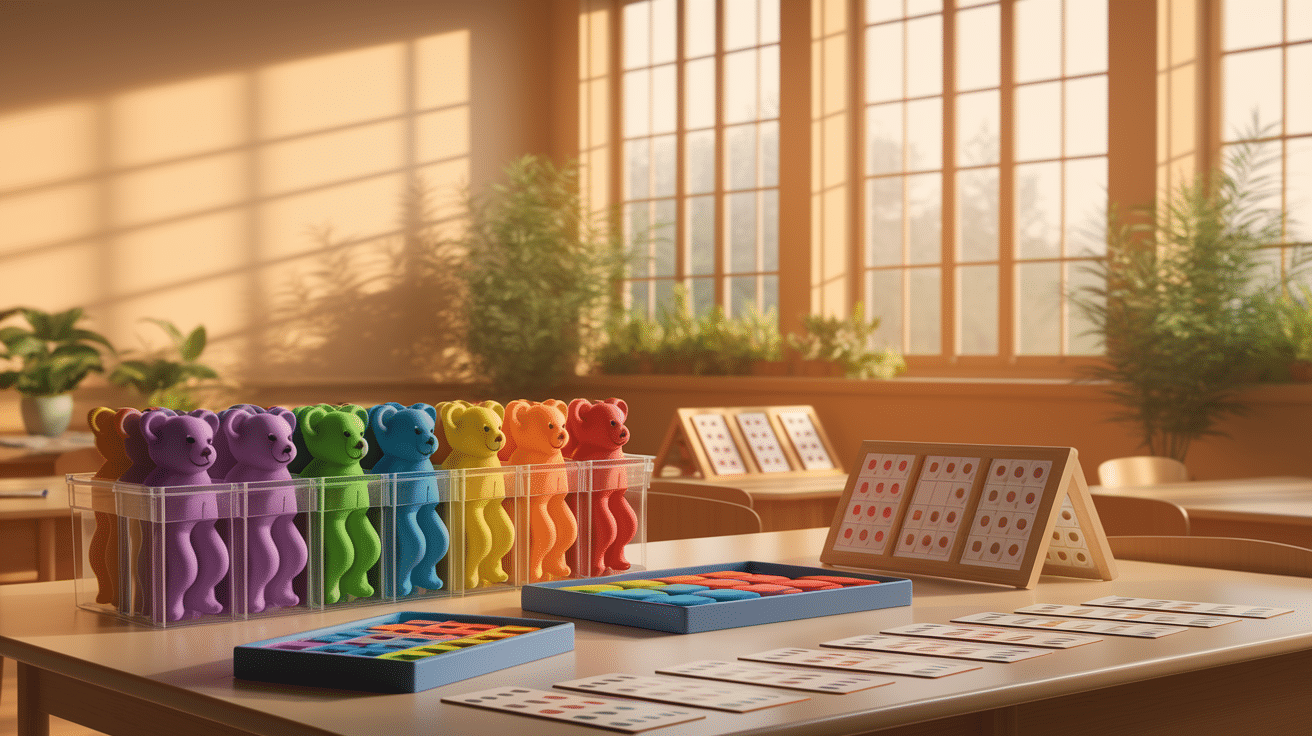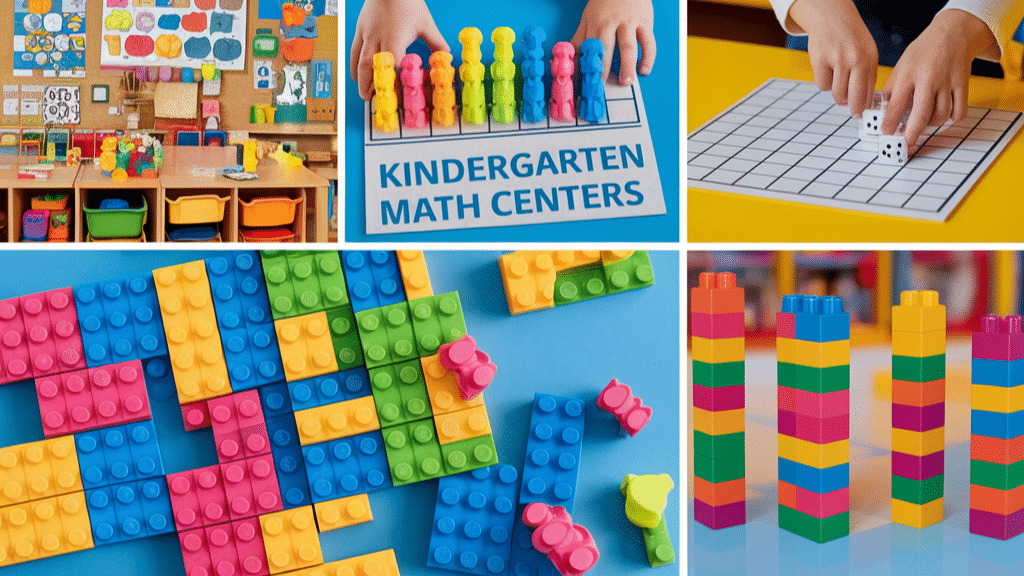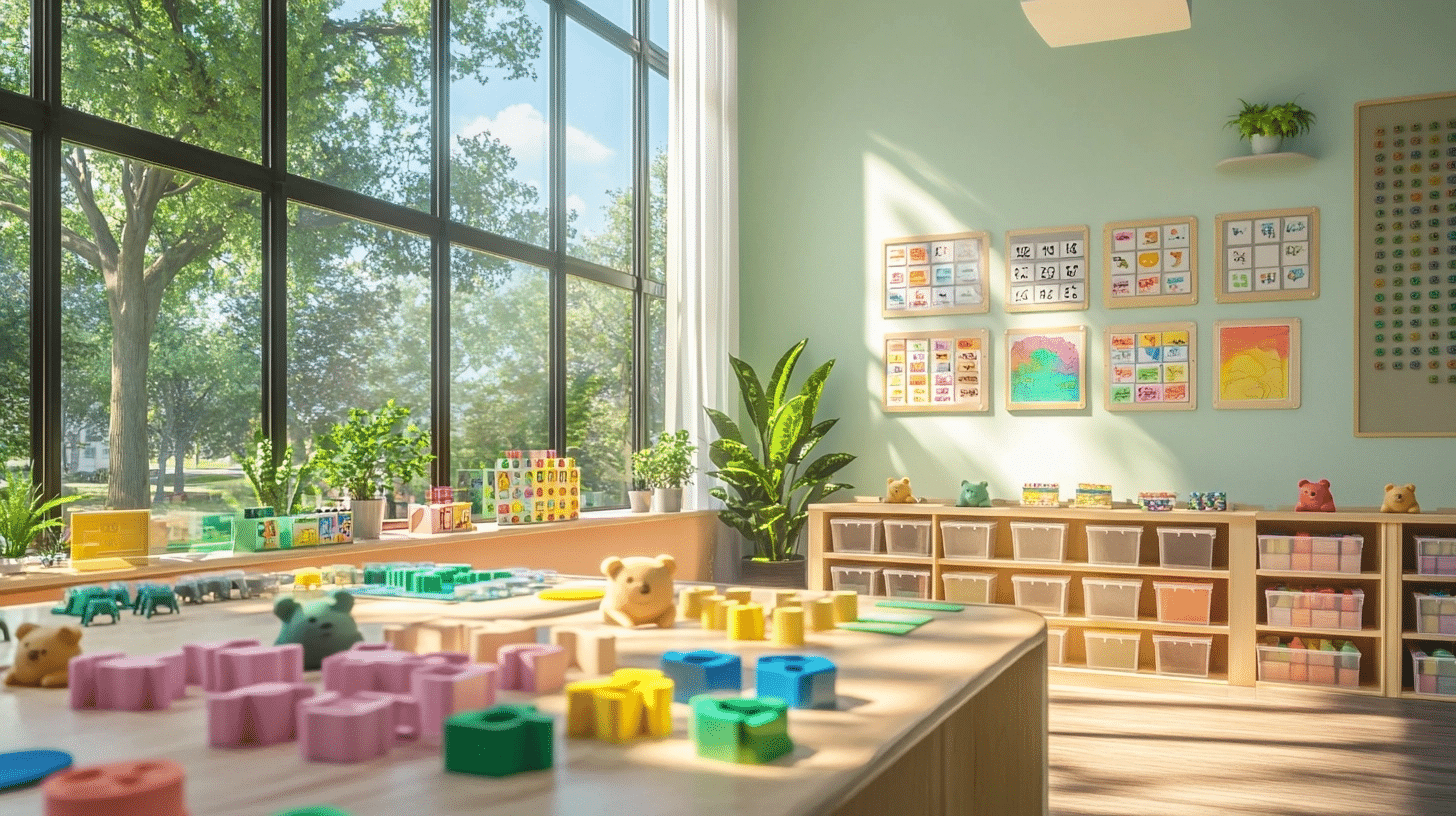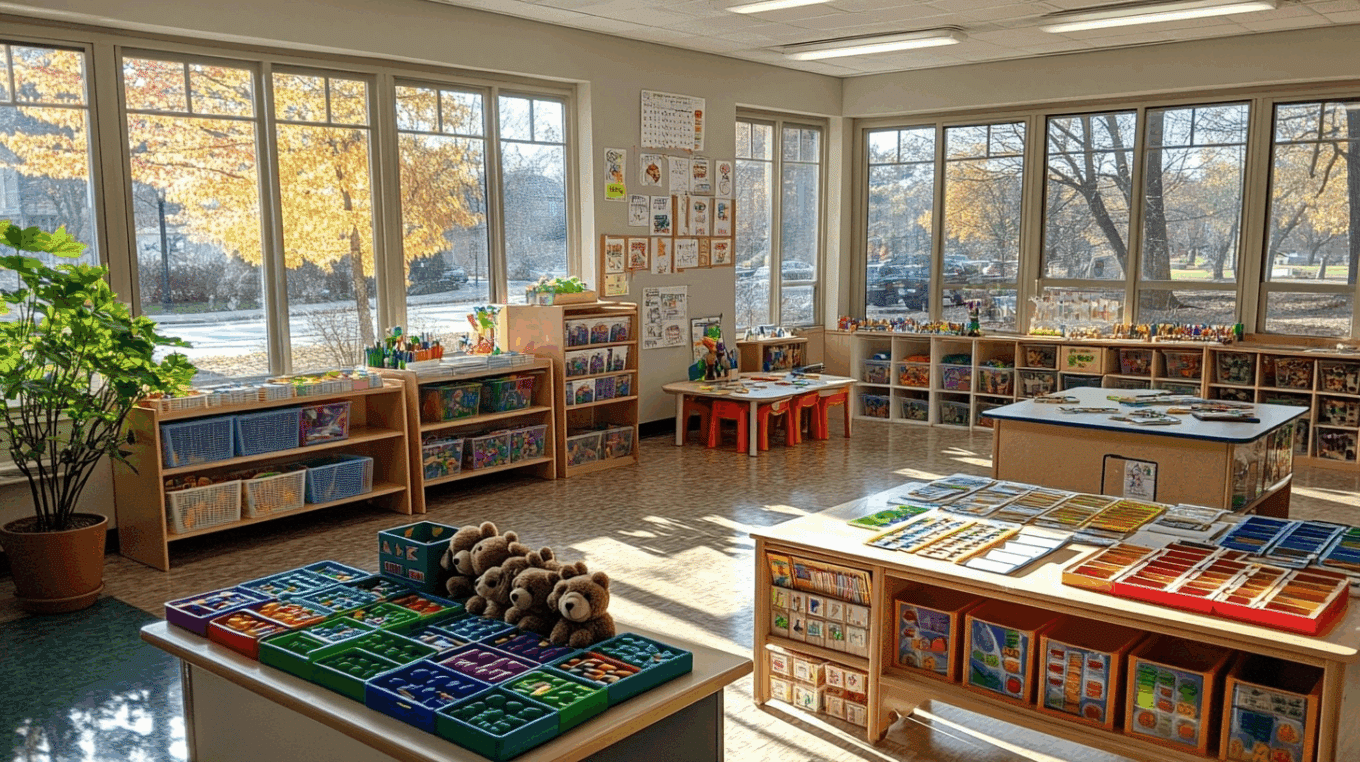Do your kids groan when it’s time for math? Many young students view numbers as boring or hard. But it doesn’t have to be this way!
Kids actually love to count, sort, and play with shapes. The key is making these activities fun rather than tedious. Kindergarten math centers offer the perfect solution to turn math anxiety into math excitement.
Why Kindergarten Math Centers? The Benefits for Young Learners

Math centers can be very beneficial for children just starting school. These small-group stations let children learn at their own speed in a way that feels like play.
When youngsters use math centers, they get to touch and move items while they count. This hands-on method helps ideas stick better than simply looking at worksheets. Kids who might feel shy about speaking up in front of everyone often shine when working with just a few friends.
These centers also build social skills as children take turns, share materials, and help each other solve problems. Teachers notice they can watch each student more closely and give extra help where needed.
The beauty of math centers is that they meet each child where they are.
Fast learners can try harder tasks, while others get more practice with the basics. This personal approach makes learning math feel good for every student in the room.
Must-Have Materials for Hands-On Learning
Every great math center starts with the right materials.
The right tools help little hands find, count, and create, making abstract concepts feel real and exciting. When you stock your centers with hands-on items, you’re setting kids up for joyful, active learning.
Here’s a quick table of must-have materials and what each one is perfect for:
| Material | Purpose in Math Centers |
|---|---|
| Counting Bears | Sorting, counting, patterns |
| Dice | Number recognition, addition, and games |
| Linking Cubes | Building, measuring, and comparing numbers |
| Play Dough | Shaping numbers, hands-on counting |
| Number Cards | Matching, sequencing, and memory games |
| Clothespins | Fine motor practice, number matching |
| Pattern Blocks | Shapes, symmetry, and pattern building |
| Ten Frames | Visualizing numbers, early addition |
| Mini Whiteboards | Drawing, writing numbers, and quick checks |
| Spinners | Random number generation, games |
Creative and Engaging Kindergarten Math Centers Ideas

These math centers bring joy to number learning through play-based methods that keep kids’ interest. Each option below uses simple items you likely already have in your classroom.
1. Counting Bears Sorting
Let children sort colorful counting bears by color or size into cups or trays. When kids group these little bears, they build sorting skills and learn to count out loud.
As they work, they can see the difference between “more” and “less” right in front of them.
- Ask students to create patterns with the bears
- Have them count how many bears of each color they sorted
- Try sorting by both color and size for older kids
2. Roll and Cover
This game has kids roll a die and then cover the matching number on their game board with counters. It helps them:
- Recognize numbers quickly
- Practice counting dots on the dice
- Build hand control as they place small counters
3. Shape Hunt
Students walk around the classroom looking for items that match specific shapes like circles or squares. This simple activity connects math ideas to things kids see every day. They learn to spot shapes in unexpected places and talk about what makes each shape special.
4. Button Counting
Children sort buttons by color or size, placing them in matching containers while counting each one. This builds:
- Counting skills as they track each button
- Sorting abilities through grouping similar items
- Fine motor skills are developed by handling small objects
5. Ten Frame Fill
Kids place counters on ten frames based on a number card they draw. This visual method makes numbers come alive.
Children see how 7 fills most of a ten frame while 3 takes up just part of it. They start to understand how numbers work together and build toward addition skills.
6. Domino Match Up
Children match dominoes to number cards or put them in order from smallest to largest. This helps them:
- Count dots quickly without having to count each one.
- Connect the written numbers to the dots they represent.
- Pay close attention to details as they look for matches.
7. Subtraction Smash
This hands-on center has kids roll out small play-dough balls and then smash a few to solve simple take-away problems. Children love the physical action of “taking away” by smashing the dough. It makes subtraction real instead of marks on paper.
8. Popsicle Stick Ordering
Students arrange numbered popsicle sticks from 1 to 10 or higher. As they put the sticks in order, they learn the correct number sequence and practice careful handling of small objects. This simple activity builds the foundation for counting forward and backward.
9. Pattern Block Designs
Kids create pictures or repeat patterns using colored blocks. While they work, they learn about:
- Shapes and how they fit together
- Repeating patterns like red-blue-red-blue
- Space and how to fill it in creative ways
This center lets children make math beautiful while learning important space concepts.
10. Clothespin Addition
Children clip clothespins onto cards to show different ways to make numbers. For example, they might clip two clothespins showing “2” and “3” onto a card labeled “5.”
- Strengthens finger muscles for writing
- Shows multiple ways to create the same number
- Makes addition concrete and visual
11. Number Line Hop
This active center uses a floor number line where kids hop to solve simple math problems. They might start at 3 and hop forward 2 more to find the sum of 5. Moving their bodies helps many children learn better than sitting still, especially those who need to move to think.
12. Stacking Cups
Kids stack numbered cups in order or build towers with a specific number of cups. This fun center mixes counting and building into one activity.
- Improves hand-eye coordination
- Teaches counting and sequence
- Shows numbers getting larger as towers grow taller
- Brings satisfaction of building something
13. Building Blocks Counting
Children build towers with a set number of blocks, saying each number as they add pieces. This center makes counting real as kids see their towers grow with each number. They learn that each number matches exactly one block, which is a key math idea for young learners.
14. What Comes Next?
Students look at a row of numbers or shapes and figure out what should come next in the pattern.
This thinking activity builds key mental skills as children notice how things repeat or change in the world around them. When kids study a pattern and predict what comes next, they learn to make smart guesses based on clues they see.
15. Number Hunt
- Kids search for hidden numbers around the classroom.
- They record each found number on a simple worksheet.
- Students get to move and learn at the same time.
- Teachers can hide numbers that match current learning goals
- Builds excitement as children race to find all the numbers
16. Fill Up Ten Frames
This center uses mini erasers, small toys, or even snacks to fill ten frames for different numbers. Children place items one by one into the frames, learning how numbers relate to ten. The variety of materials keeps this activity fresh even when repeated often.
- Helps visualize numbers from 1-10
- Shows relationships between numbers
- Builds a foundation for place value
- Makes abstract numbers concrete
17. Subtraction Bowling
Children set up small pins, knock some down with a ball, and subtract the fallen pins from the total. This turns subtraction into a game full of excitement and movement.
Kids love seeing the pins fall and counting how many are left. The physical nature of this activity helps math concepts stick in their memory.
18. Color Matching
- Match colored items to containers of the same color
- Count items as they sort them
- Learn colors and numbers together
- Practice one-to-one counting with each object
- Compare which color group has more or less
19. Tube Addition
Children drop objects into clear tubes to show different ways to make a target number. For example, they might put 3 pom-poms in one tube and 4 in another to make 7. The clear tubes let them see the parts that make up a whole number.
This center works great for adding three numbers, too, using three tubes to create one sum.
20. Learning with Balloons
This lively center has students find balloons with numbers and either match or order them. The movement and bright colors make number practice exciting instead of boring.
- Adds fun movement to math time
- Connects physical actions with number ideas
- Creates excitement through unusual materials
- Works well for group activities
- Can adjust difficulty by changing the number range
21. Ordering Legos
This playful center combines the joy of building with important number skills. Children stack numbered Legos in the correct order from 0 to 20, creating a colorful tower that visually shows the number sequence.
As they search for each number and click the pieces together, they strengthen their fingers while cementing number order in their minds.
Setting Up for Success: Routines and Expectations
Before jumping into math centers, take time to set clear rules and routines. When kids know what to do, they can focus on learning instead of wondering what comes next.
| Setup Step | Why It Matters | What To Do |
|---|---|---|
| Model Each Center | Prevents confusion | Show the whole class how to use materials and complete tasks before they try on their own |
| Rotation System | Keeps order | Use a timer, music signals, or visual cues to show when it’s time to move to the next center. |
| Cleanup Routine | Builds responsibility | Teach a specific way to put materials back, perhaps with photos showing where items belong. |
| Noise Level | Helps concentration | Establish “math center voices” with clear examples of acceptable volume |
| Help System | Builds independence | Create a “three before me” rule where kids ask three peers before the teacher. |
| Group Size | Manages materials | Limit 3-4 students per center to ensure everyone gets hands-on time |
Tips for Smooth Transitions and Group Management

Moving between kindergarten math centers can be chaotic without good systems in place. These simple tips will help your math time flow better while keeping students engaged and focused on their learning tasks.
- Use visual timers so children can see how much time remains at each center.
- Play soft music as a signal for cleanup and transition between activities.
- Create picture cards showing which kindergarten math centers each child visits.
- Assign a “center captain” to help peers with materials and basic questions.
- Keep materials in clear, labeled bins for easy access and cleanup.
- Use color-coding to help students find their next station quickly.
- Establish a quiet signal that works even when the room gets noisy.
- Practice transitions regularly until they become automatic.
- Start with just 2-3 centers before gradually adding more options.
Wrapping It Up
Math centers bring joy to early number learning. When young students get hands-on practice with counting, shapes, and patterns, they build skills that last a lifetime.
The kindergarten math centers in this guide offer more than just fun; they create a foundation for future math success. Each activity turns abstract ideas into something children can touch, move, and understand.
By making math playful and physical through these centers, you help children see themselves as capable math thinkers from the very beginning; perhaps the greatest gift we can give our youngest learners.
What center will you try first?




